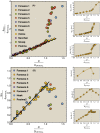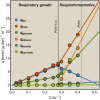Searching for principles of microbial physiology
- PMID: 33099619
- PMCID: PMC7685786
- DOI: 10.1093/femsre/fuaa034
Searching for principles of microbial physiology
Abstract
Why do evolutionarily distinct microorganisms display similar physiological behaviours? Why are transitions from high-ATP yield to low(er)-ATP yield metabolisms so widespread across species? Why is fast growth generally accompanied with low stress tolerance? Do these regularities occur because most microbial species are subject to the same selective pressures and physicochemical constraints? If so, a broadly-applicable theory might be developed that predicts common microbiological behaviours. Microbial systems biologists have been working out the contours of this theory for the last two decades, guided by experimental data. At its foundations lie basic principles from evolutionary biology, enzyme biochemistry, metabolism, cell composition and steady-state growth. The theory makes predictions about fitness costs and benefits of protein expression, physicochemical constraints on cell growth and characteristics of optimal metabolisms that maximise growth rate. Comparisons of the theory with experimental data indicates that microorganisms often aim for maximisation of growth rate, also in the presence of stresses; they often express optimal metabolisms and metabolic proteins at optimal concentrations. This review explains the current status of the theory for microbiologists; its roots, predictions, experimental evidence and future directions.
Keywords: biophysics; constrained biosynthetic resource allocation; evolutionary biology; mathematical modelling; microbial physiology; systems biology.
© The Author(s) 2020. Published by Oxford University Press on behalf of FEMS.
Figures










References
-
- Bentley WE, Mirjalili N, Andersen DC et al. . Plasmid-encoded protein: the principal factor in the “metabolic burden" associated with recombinant bacteria. Biotechnol Bioeng. 1990;35:668–81. - PubMed

